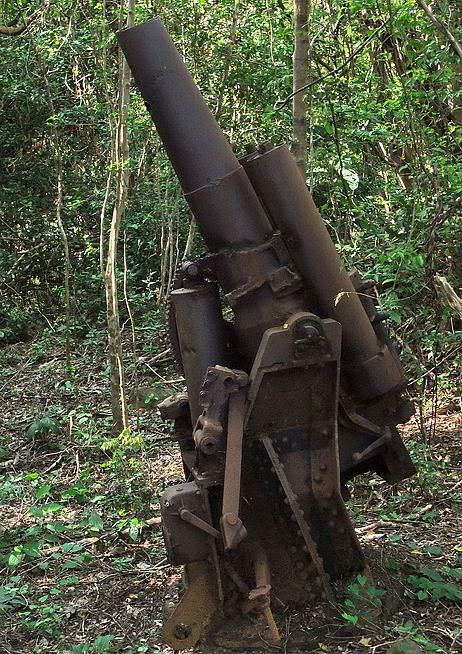Post by fots2 on Mar 29, 2013 20:47:10 GMT 8
Here are more miscellaneous views of Corregidor Island taken from various locations.
The east end of Corregidor is often ignored and receives few visitors. In addition to the unique history I find that it has some of the most impressive scenic views. The tip of the main island of Corregidor is called East Point. At low tide you can walk a bit further east to Razor Island. The eastern tip of it is called Hooker Point. An early morning trip to the tail means that the sun is shining directly into the camera lens but sometimes the results are not too bad.

At low tide along the south side of the island we are looking towards the curved tail of Corregidor. The glare of the sun made this photo very dark so I took it a step further to pure black and white.

Standing at East Point (seen to the right), the jagged profile of Razor Island sits opposite exposed rock during low tide. It is easy to get over there but be prepared to get your feet wet as the rocks can be slippery. In the distance is Caballo Island and on the far side of Manila Bay, the province of Cavite.

Razor Island.

Looking across the curved tail of Corregidor you can see the top of an old volcano on Bataan called Mount Mariveles.

I have posted this view before but I never get tired of it. The eastern tip of Corregidor, Caballo and Cavite.

Overlooking the north part of Bottomside was an old dual siege gun position named VII-S-2. During WWII is was equipped with two 155mm guns and known as Battery Martin. This photo shows the magazine located between the two gun positions.

Interior view of the magazine.

Battery Crockett Gun #1.

Looking across Battery Crockett. The destroyed Battery Control station sits on top of the battery.

At the north part of Bottomside we can see (from near to far) Lorcha Dock, North Dock and Engineer Dock.

The statue of General Douglas MacArthur near Lorcha Dock. The three words at the bottom were NOT uttered by him on Corregidor.

Wandering off road around Corregidor has a few hazzards and one of them is deep open holes. Sometimes grasses and bushed hide them from view. If you like to walk along while watching the monkeys in the tree tops then you may have a bad day. Here is one of the Battery Smith air shafts.

Looking down the air shaft.

Recent structural reinforcement to the Topside Cine has been completed. A section of one side wall had already collapsed and the rest of it was leaning badly. The reinforcement looks well done and the structure should last much longer now. Good job CFI.

Another view of the steel reinforcement.
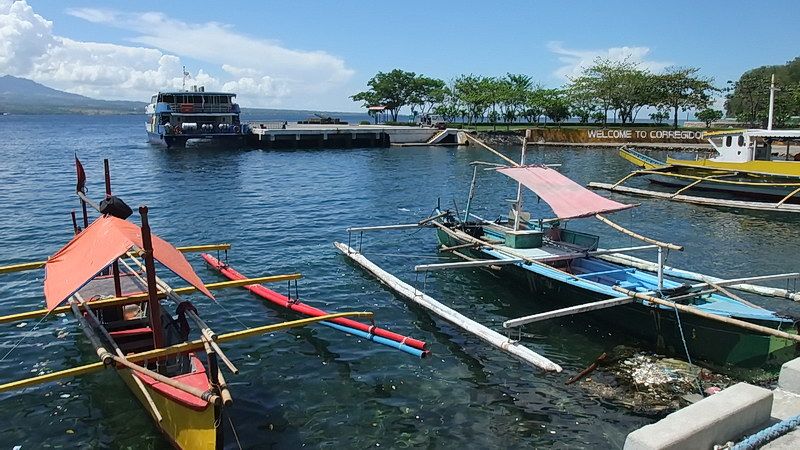
The North Dock area of Bottomside.

The shelter tunnel and operating platform for Searchlight #8 on the eastern slope of Malinta Hill.

An early morning view of one of the Topside Senior Officer’s Quarters.

The eastern parapet of Battery Wheeler.

The south western coast of Corregidor is difficult to access and when walking it requires some effort to get there. When finished, getting back up the hot steep ravines is more strenuous. One day after completing our planned explorations, Karl and I decided to get back to Bottomside the easy way. A local fishing boat was the answer. Here we see the boat captain with his finger on the throttle string and Junior busy at leeping us afloat. Actually they did a great job and we appreciated getting a cold drink hours earlier than if we had to climb back up and walk all the way to Bottomside.

In addition to tunnels, one of the hurried defenses constructed during wartime would have been bunkers. Corregidor has lots of them. This one is made out of scavenged trolley line ties. Today it is collapsed inside and is only about ten feet deep. I do not know if this is due to battle damage or the affects of so many years of decay. Time would be my guess.

Interior of the now collapsed bunker.

It was a rough day on the North Channel as Karl headed back home. No charge for the free shower.

Inside the VI-F-3 field gun position at Geary Point, I am looking down the cliff toward the beach.

In out of the way areas, lots of booze bottles still lie around the island. This one is from a Manila company named La Fuerza Inc. A quick internet search says they sold wines and Liquors.

The Fort Mills Commander’s Station (C1) has azimuth and range numbers stenciled on the inside walls. This corner obviously faces Mariveles.

On a very rare day, the air is extremely clear and you can see for many miles. From on top of Malinta Hill, here is a x5 zoomed photo of the high-rise buildings of Metro Manila. Corregidor Inn staff have told me that at New Years time, they go to the Topside Lighthouse at midnight and watch the fireworks from Manila.

Battery Cheney 12-inch Gun #1.

Stamp on the breach end of Battery Cheney Gun #1.

Stamp on the muzzle end of Battery Cheney Gun #2.

A concrete water tank destroyed during the war.

Field repairs when my boot soles fell off. This bright idea lasted all of ten minutes! I should carry the “handy man’s secret weapon”, duct tape. Note to self: do not let local shoe repair people touch my boots again.

Part of the Mile Long Barracks as seen from the Senior Officer’s Quarters. The Topside Parade Ground is in the middle.

Recently we passed by this Japanese AA gun again on our way back to Bottomside. Scrappers removed part of the long barrel quite a few years ago. This gun is noted as the only Japanes gun on Corregidor to still be standing in its wartime position. It is located within a circular soil embankment and ringed with some smaller defensive positions on the outside which face downhill.

The Sun Cruises ferry has arrived from Manila and the day tourists head for their assigned tour buses.

Adjacent to the North Dock is the Clinic (on the left) and CFI headquarters (on the right).

The view from Geary Point looking west. La Monja Island is that small chunk of rock sticking up at the far left.

The corral and stable for the horses on Corregidor was at Middleside. At this location only foundations of the buildings remain with one exception. A concrete trough with a drain hole in the corner still sits overturned on the ground.

Looking out the entrance of one of Corregidor’s many tunnels.

These narrow concrete steps lead up the hill toward the Corregidor Elementary School in Barrio Concepcion. Metal handrails are long gone.

Two of the early land defense positions, 1-M-1 and 1-F-1, have been transformed into the Jabidah memorial. Here I am standing above the Gun #1 position of 1-F-1 and looking towards Kindley Airfield at the right.

One deficiency that the Fort Mills commanding generals identified pre-war was the lack of bomb-proof storage on Corregidor. With few exceptions most QMC storage facilities were in buildings above ground. All of them that I can think of at the moment are damaged to some degree. The walls still exist at this warehouse.

This warehouse was not so fortunate.

Battle damage to another warehouse.

This warehouse has a few holes in it but is in relatively good shape.

A look at the north section of Bottomside taken from the gun shelter on top of Malinta Hill.

The Bottomside vehicle maintenance area has a lone shell sitting there perhaps destined for future display.

I did not realize that there was any Marsden Matting on Corregidor until I noticed this recently. It may have been brought to the island post war.

It is rare to see metal window shutters still existing on reinforcd concrete buildings. Most have been removed over the years for scrap I assume.
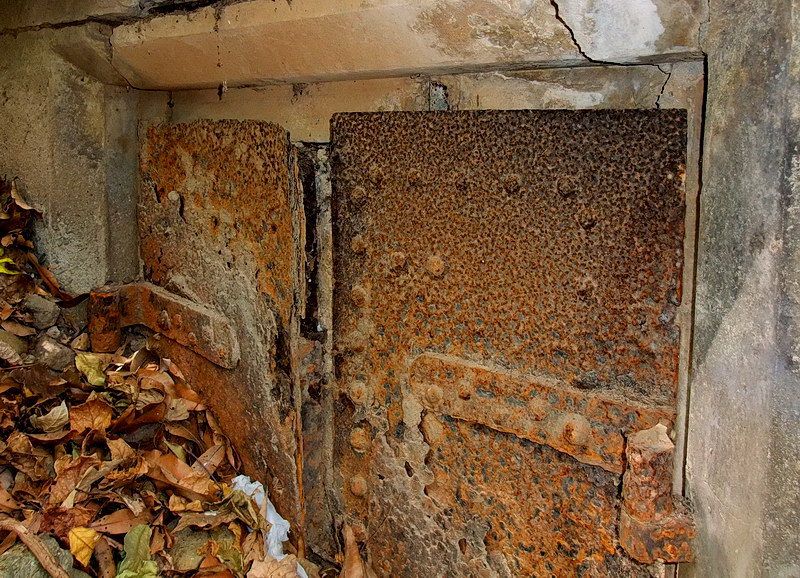
Another window with metal shutters.
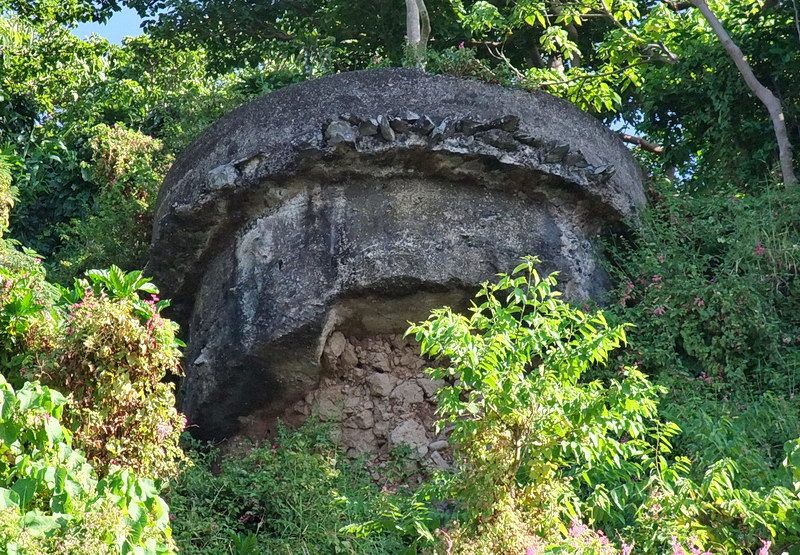
Gun Position #1 of Battery Cushing will come crashing down someday. This is a zoomed shot of it looking up from the beach. VIII-F-2 right beside Battery Cushing has already fallen down onto the beach.

Imagine a field gun position at the top of a cliff overlooking the south beach. Also, there is a set of concrete steps at the rear of the gun position. Over time the cliff face erodes away and the gun position falls down onto the beach. As the gun position slides down it breaks away from the steps which remain at the top. Well, that is what happened to VIII-F-2. Here are the steps “to nowhere” unless your destination is the beach below you.
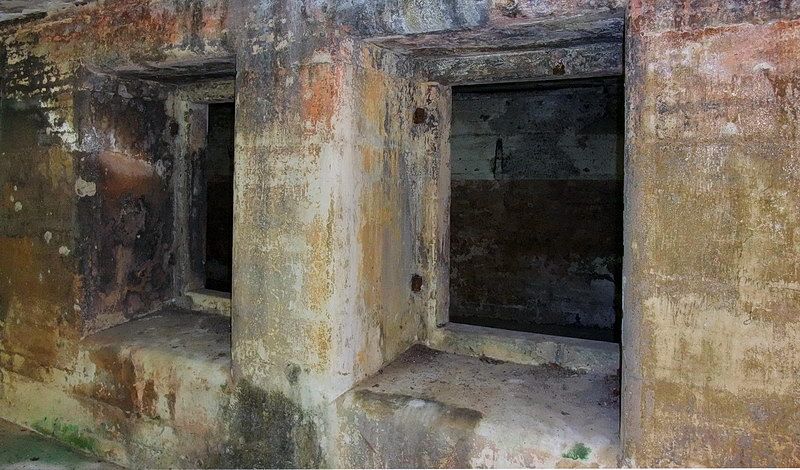
The three 12-inch disappearing gun batteries of Crockett, Wheeler and Cheney are not identical but quite similar. Here is a look at how thick the rear walls are. You can see the hinges that used to secure the metal shutters.
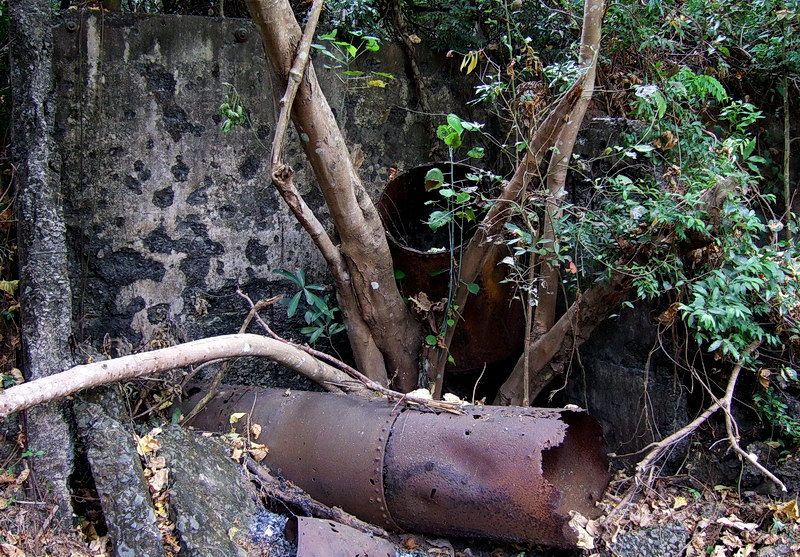
The smoke stack at one of Corregidor’s crematoriums.

Associated with the Army’s electrical anti-ship mines, this is the Instrument Storehouse Casemate.

One of the rooms inside this casemate.

The eastern tip of Corregidor Island viewed from offshore. I think we were returning from Fort Frank that day.

Looking out the shelter entrance at Searchlight #6.

A view of the first set of steps at the underground magazine for a 3-inch Anti-aircraft gun. This magazine is near Middleside.

The view back up that same set of steps. Another set of steps up to ground level is behind me. This is the second entrance. Perpendicular to where I am standing is a third set of steps down to the actual magazine.

Two levels underground, I am standing in the AA gun’s magazine.

At the rear of the 1000 Man Tunnel is a deep vertical airshaft. I wonder who threw trolley line ties down here.

Early morning photo at Battery Wheeler.

Here is a new stitch of four photos showing Bottomside and the western section of Corregidor Island. The Inn staff recently cut some trees on top of Malinta Hill that allows for a better panoramic view.

A sign at Bottomside.
The east end of Corregidor is often ignored and receives few visitors. In addition to the unique history I find that it has some of the most impressive scenic views. The tip of the main island of Corregidor is called East Point. At low tide you can walk a bit further east to Razor Island. The eastern tip of it is called Hooker Point. An early morning trip to the tail means that the sun is shining directly into the camera lens but sometimes the results are not too bad.

At low tide along the south side of the island we are looking towards the curved tail of Corregidor. The glare of the sun made this photo very dark so I took it a step further to pure black and white.

Standing at East Point (seen to the right), the jagged profile of Razor Island sits opposite exposed rock during low tide. It is easy to get over there but be prepared to get your feet wet as the rocks can be slippery. In the distance is Caballo Island and on the far side of Manila Bay, the province of Cavite.

Razor Island.

Looking across the curved tail of Corregidor you can see the top of an old volcano on Bataan called Mount Mariveles.

I have posted this view before but I never get tired of it. The eastern tip of Corregidor, Caballo and Cavite.

Overlooking the north part of Bottomside was an old dual siege gun position named VII-S-2. During WWII is was equipped with two 155mm guns and known as Battery Martin. This photo shows the magazine located between the two gun positions.

Interior view of the magazine.

Battery Crockett Gun #1.

Looking across Battery Crockett. The destroyed Battery Control station sits on top of the battery.

At the north part of Bottomside we can see (from near to far) Lorcha Dock, North Dock and Engineer Dock.

The statue of General Douglas MacArthur near Lorcha Dock. The three words at the bottom were NOT uttered by him on Corregidor.

Wandering off road around Corregidor has a few hazzards and one of them is deep open holes. Sometimes grasses and bushed hide them from view. If you like to walk along while watching the monkeys in the tree tops then you may have a bad day. Here is one of the Battery Smith air shafts.

Looking down the air shaft.

Recent structural reinforcement to the Topside Cine has been completed. A section of one side wall had already collapsed and the rest of it was leaning badly. The reinforcement looks well done and the structure should last much longer now. Good job CFI.

Another view of the steel reinforcement.

The North Dock area of Bottomside.

The shelter tunnel and operating platform for Searchlight #8 on the eastern slope of Malinta Hill.

An early morning view of one of the Topside Senior Officer’s Quarters.

The eastern parapet of Battery Wheeler.

The south western coast of Corregidor is difficult to access and when walking it requires some effort to get there. When finished, getting back up the hot steep ravines is more strenuous. One day after completing our planned explorations, Karl and I decided to get back to Bottomside the easy way. A local fishing boat was the answer. Here we see the boat captain with his finger on the throttle string and Junior busy at leeping us afloat. Actually they did a great job and we appreciated getting a cold drink hours earlier than if we had to climb back up and walk all the way to Bottomside.

In addition to tunnels, one of the hurried defenses constructed during wartime would have been bunkers. Corregidor has lots of them. This one is made out of scavenged trolley line ties. Today it is collapsed inside and is only about ten feet deep. I do not know if this is due to battle damage or the affects of so many years of decay. Time would be my guess.

Interior of the now collapsed bunker.

It was a rough day on the North Channel as Karl headed back home. No charge for the free shower.

Inside the VI-F-3 field gun position at Geary Point, I am looking down the cliff toward the beach.

In out of the way areas, lots of booze bottles still lie around the island. This one is from a Manila company named La Fuerza Inc. A quick internet search says they sold wines and Liquors.

The Fort Mills Commander’s Station (C1) has azimuth and range numbers stenciled on the inside walls. This corner obviously faces Mariveles.

On a very rare day, the air is extremely clear and you can see for many miles. From on top of Malinta Hill, here is a x5 zoomed photo of the high-rise buildings of Metro Manila. Corregidor Inn staff have told me that at New Years time, they go to the Topside Lighthouse at midnight and watch the fireworks from Manila.

Battery Cheney 12-inch Gun #1.

Stamp on the breach end of Battery Cheney Gun #1.

Stamp on the muzzle end of Battery Cheney Gun #2.

A concrete water tank destroyed during the war.

Field repairs when my boot soles fell off. This bright idea lasted all of ten minutes! I should carry the “handy man’s secret weapon”, duct tape. Note to self: do not let local shoe repair people touch my boots again.

Part of the Mile Long Barracks as seen from the Senior Officer’s Quarters. The Topside Parade Ground is in the middle.

Recently we passed by this Japanese AA gun again on our way back to Bottomside. Scrappers removed part of the long barrel quite a few years ago. This gun is noted as the only Japanes gun on Corregidor to still be standing in its wartime position. It is located within a circular soil embankment and ringed with some smaller defensive positions on the outside which face downhill.

The Sun Cruises ferry has arrived from Manila and the day tourists head for their assigned tour buses.

Adjacent to the North Dock is the Clinic (on the left) and CFI headquarters (on the right).

The view from Geary Point looking west. La Monja Island is that small chunk of rock sticking up at the far left.

The corral and stable for the horses on Corregidor was at Middleside. At this location only foundations of the buildings remain with one exception. A concrete trough with a drain hole in the corner still sits overturned on the ground.

Looking out the entrance of one of Corregidor’s many tunnels.

These narrow concrete steps lead up the hill toward the Corregidor Elementary School in Barrio Concepcion. Metal handrails are long gone.

Two of the early land defense positions, 1-M-1 and 1-F-1, have been transformed into the Jabidah memorial. Here I am standing above the Gun #1 position of 1-F-1 and looking towards Kindley Airfield at the right.

One deficiency that the Fort Mills commanding generals identified pre-war was the lack of bomb-proof storage on Corregidor. With few exceptions most QMC storage facilities were in buildings above ground. All of them that I can think of at the moment are damaged to some degree. The walls still exist at this warehouse.

This warehouse was not so fortunate.

Battle damage to another warehouse.

This warehouse has a few holes in it but is in relatively good shape.

A look at the north section of Bottomside taken from the gun shelter on top of Malinta Hill.

The Bottomside vehicle maintenance area has a lone shell sitting there perhaps destined for future display.

I did not realize that there was any Marsden Matting on Corregidor until I noticed this recently. It may have been brought to the island post war.

It is rare to see metal window shutters still existing on reinforcd concrete buildings. Most have been removed over the years for scrap I assume.

Another window with metal shutters.

Gun Position #1 of Battery Cushing will come crashing down someday. This is a zoomed shot of it looking up from the beach. VIII-F-2 right beside Battery Cushing has already fallen down onto the beach.

Imagine a field gun position at the top of a cliff overlooking the south beach. Also, there is a set of concrete steps at the rear of the gun position. Over time the cliff face erodes away and the gun position falls down onto the beach. As the gun position slides down it breaks away from the steps which remain at the top. Well, that is what happened to VIII-F-2. Here are the steps “to nowhere” unless your destination is the beach below you.

The three 12-inch disappearing gun batteries of Crockett, Wheeler and Cheney are not identical but quite similar. Here is a look at how thick the rear walls are. You can see the hinges that used to secure the metal shutters.

The smoke stack at one of Corregidor’s crematoriums.

Associated with the Army’s electrical anti-ship mines, this is the Instrument Storehouse Casemate.

One of the rooms inside this casemate.

The eastern tip of Corregidor Island viewed from offshore. I think we were returning from Fort Frank that day.

Looking out the shelter entrance at Searchlight #6.

A view of the first set of steps at the underground magazine for a 3-inch Anti-aircraft gun. This magazine is near Middleside.

The view back up that same set of steps. Another set of steps up to ground level is behind me. This is the second entrance. Perpendicular to where I am standing is a third set of steps down to the actual magazine.

Two levels underground, I am standing in the AA gun’s magazine.

At the rear of the 1000 Man Tunnel is a deep vertical airshaft. I wonder who threw trolley line ties down here.

Early morning photo at Battery Wheeler.

Here is a new stitch of four photos showing Bottomside and the western section of Corregidor Island. The Inn staff recently cut some trees on top of Malinta Hill that allows for a better panoramic view.

A sign at Bottomside.













